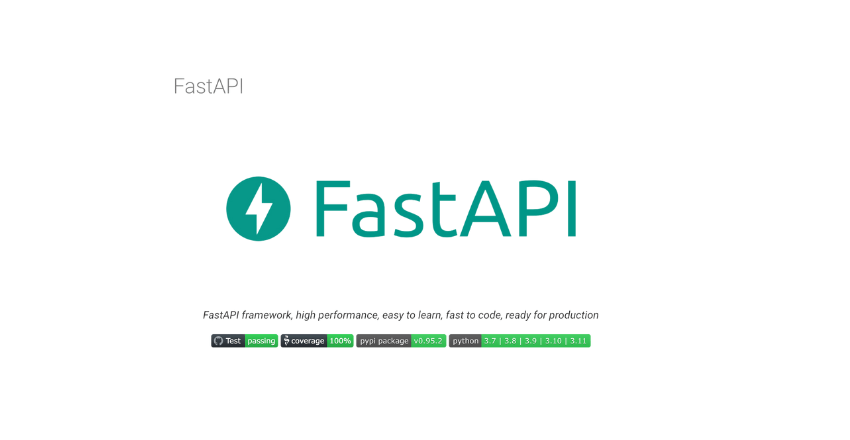When does FastAPI make sense for your project? If speed and modernity rank high, let’s dive deeper. In the world of web development, selecting an appropriate framework often sparks heated debates.

A newcomer has recently made its way into the arena, turning heads with its remarkable features. FastAPI now stands tall among seasoned veterans like Django and Flask.
However, when does this modern, high-speed, easy-to-use framework truly shine?
Let’s embark on a journey to answer: When does FastAPI make sense for your project?
A Brief Backstory of FastAPI
In 2018, Sebastián Ramírez introduced FastAPI. He created this framework aiming to bridge gaps he found in existing Python frameworks. The inception of FastAPI marks an important milestone in our story.
FastAPI was born out of a desire for speed, ease of use, and versatility. From the outset, Ramírez envisioned a tool that would simplify and speed up Python web development. His creation resulted in a unique framework, designed with modernity and developer comfort in mind.
Key Takeaway: FastAPI was created to address the need for speed, ease, and versatility in Python web development.
Understanding the Strengths of FastAPI
Speed and Performance
One of FastAPI’s most impressive qualities is its speed. Benchmarks from 2021 show that FastAPI rivals NodeJS and Go, leaving traditional Python frameworks far behind. Such a speed boost can enhance user experience and reduce server costs, making FastAPI an attractive choice for projects where performance is crucial.
Pro Tip: Consider FastAPI for high-performance applications, as its speed can enhance user experience and reduce server costs.
Exemplify: For instance, if you’re building a real-time application like a chat app, FastAPI’s exceptional speed can ensure smooth, real-time communication between users.
Key Takeaway: When performance and speed are paramount, FastAPI makes perfect sense.
Ease of Use and Developer Experience
FastAPI’s ease of use is another reason developers flock to it. FastAPI leverages Python’s type hints, making your code more readable and self-documenting. Moreover, this framework automatically generates interactive API documentation, a feature that can save developers hours of manual work.
Pro Tip: Use FastAPI when you need to quickly prototype and iterate, as its self-documenting nature can speed up the development process.
Exemplify: Imagine you’re creating an API for an e-commerce platform. With FastAPI, you can quickly iterate on your endpoints, while the automatic API documentation keeps your team and stakeholders in the loop.
Key Takeaway: FastAPI makes sense when you need to quickly prototype or when clear documentation is important.
Expert opinion:
“If anyone is looking to build a production Python API, I would highly recommend FastAPI. It is beautifully designed, simple to use and highly scalable, it has become a key component in our API first development strategy and is driving many automations and services such as our Virtual TAC Engineer.” Deon Pillsbury – Cisco (Ref)
Asynchronous Support
Another significant advantage of FastAPI is its built-in support for asynchronous programming. Asynchronous programming allows your application to handle multiple operations concurrently, which can significantly improve performance for IO-bound operations.
Pro Tip: Use FastAPI in projects where you’ll be dealing with many IO-bound operations, like network calls or disk reads.
Exemplify: Suppose your project involves building a web scraper. FastAPI’s asynchronous support will allow your application to make multiple requests concurrently, speeding up the scraping process.
Key Takeaway: For IO-bound projects, FastAPI’s asynchronous support is a game-changer.
FastAPI and Data Validation

FastAPI’s built-in data validation is another jewel in its crown. Leveraging Pydantic for data validation, FastAPI ensures that the data your application receives and sends is of the correct type, reducing runtime errors.
Pro Tip: FastAPI should be your go-to choice when dealing with complex data inputs and you want to ensure data integrity without writing extensive validation logic yourself.
Exemplify: If you’re working on a project involving machine learning models where the model’s input data needs to be of a specific type and structure, FastAPI’s automatic request validation can be a lifesaver.
Key Takeaway: FastAPI’s data validation is a powerful tool for maintaining data integrity and reducing bugs, making it a good choice for data-intensive applications.
Integration with Modern Python Features
FastAPI’s compatibility with modern Python features, such as async and await, is another strong selling point. This compatibility allows developers to write more efficient, non-blocking code, resulting in highly responsive applications.
Pro Tip: FastAPI is an excellent choice for applications where real-time responsiveness is a key requirement.
Exemplify: Imagine a highly interactive web application, such as a multiplayer online game or a live event streaming service. FastAPI’s compatibility with async and await can help ensure that users can interact with the application smoothly and without delay.
Key Takeaway: FastAPI is an excellent choice when you need to write highly efficient, non-blocking code and create responsive applications.
Dependency Injection System
FastAPI’s dependency injection system is another feature that stands out. It allows you to manage and control your dependencies effectively, leading to more maintainable and testable code.
Pro Tip: Consider FastAPI when your project involves numerous dependencies or when you need to maintain an elevated level of code quality and testability.
Exemplify: If you’re developing a complex application with multiple services that depend on shared resources, FastAPI’s dependency injection can help manage these dependencies efficiently.
Key Takeaway: FastAPI’s dependency injection system is ideal for managing complex dependencies, leading to more maintainable and testable code.
Custom Response Model
FastAPI’s support for custom response models is another feature that makes it stand out. This feature allows you to shape the data returned by your API endpoints, ensuring that sensitive data is not inadvertently exposed, and that each response adheres to a predictable structure.
Pro Tip: Use FastAPI when you need precise control over your API’s responses, such as when working with sensitive data or when you need to guarantee a specific response structure.
Exemplify: If you’re developing an API for a banking application, FastAPI’s custom response models can ensure that sensitive information, like account numbers, isn’t accidentally included in the API responses.
Key Takeaway: FastAPI’s support for custom response models provides fine-grained control over API responses, making it an excellent choice for projects where data security and predictability are paramount.
Middleware Support
FastAPI’s middleware support is another aspect that developers will find beneficial. Middleware allows you to process requests and responses before they reach your application or the client, respectively. This feature is incredibly useful for tasks such as logging, authentication, and data compression.
Pro Tip: Consider FastAPI for projects where you need to perform specific actions on requests or responses, like logging or user authentication.
Exemplify: If you’re developing an application where every API request needs to be logged for auditing purposes, FastAPI’s middleware support can make this task straightforward and maintainable.
Key Takeaway: FastAPI’s middleware support provides flexibility in handling requests and responses, making it an excellent choice for projects requiring extensive logging or custom authentication.
When Might FastAPI Not Be the Best Choice?

Just as a craftsman knows that every tool has its place, so too must a developer understand that FastAPI, while impressive, might not always be the right choice.
For projects with simple requirements, where the speed of development matters more than the speed of the application itself, a more straightforward framework like Flask could be more suitable. Similarly, for large, complex projects, Django, with its robust ecosystem and admin interface, might be a more sensible choice.
Pros and Cons: FastAPI’s speed, ease of use, and asynchronous support are significant advantages. However, its relative youth means it doesn’t have the extensive libraries and tools available to more established frameworks like Django.
Exemplify: Consider a team building a comprehensive blogging platform. Django, with its built-in admin interface and user authentication, could save the team considerable time and resources.
Key Takeaway: FastAPI might not be the best choice for complex projects that can benefit from more mature frameworks’ extensive features and tools.
The Journey Towards the Right Choice
In the realm of web development, the ‘right’ framework often depends on the project’s specific requirements. When does FastAPI make sense for your project? It’s a question best answered by thoroughly understanding your project’s needs and aligning them with the unique features and capabilities of FastAPI.
Pro Tip: Always evaluate the needs of your project and the strengths of each framework before deciding.
As a web developer, I’ve come to appreciate FastAPI’s speed, ease of use, and asynchronous support. However, experience has taught me that understanding a tool’s strengths and weaknesses is crucial before incorporating it into a project.
Key Takeaway: FastAPI makes sense when your project demands speed, ease of use, asynchronous programming, or all the above.
In Summary
FastAPI, despite being a newcomer, has carved a significant niche in the web development landscape. Its speed, simplicity, and modern features make it an attractive choice for many projects. However, like any tool, it’s crucial to understand when to use it.
When does FastAPI make sense for your project? Hopefully, this chronological journey through FastAPI’s strengths and potential limitations has provided some clarity.
To put it in a metaphorical context, selecting a web framework is like choosing the right vehicle. A race car like FastAPI may have fantastic speed and innovative features, but sometimes, a reliable family sedan (Flask) or a versatile SUV (Django) could be more suitable.
As we wrap up this exploration, remember: each project is unique, and understanding its requirements is crucial. Select the right tool for the job, and you’ll be well on your way to creating fantastic web applications.
Lydia is a seasoned technical author, well-versed in the intricacies of software development and a dedicated practitioner of Python. With a career spanning 16 years, Lydia has made significant contributions as a programmer and scrum master at renowned companies such as Thompsons, Deloit, and The GAP, where they have been instrumental in delivering successful projects.
A proud alumnus of Duke University, Lydia pursued a degree in Computer Science, solidifying their academic foundation. At Duke, they gained a comprehensive understanding of computer systems, algorithms, and programming languages, which paved the way for their career in the ever-evolving field of software development.
As a technical author, Lydia remains committed to fostering knowledge sharing and promoting the growth of the computer science community. Their dedication to Python development, coupled with their expertise as a programmer and scrum master, positions them as a trusted source of guidance and insight. Through their publications and engagements, Lydia continues to inspire and empower fellow technologists, leaving an indelible mark on the world of scientific computer science.







